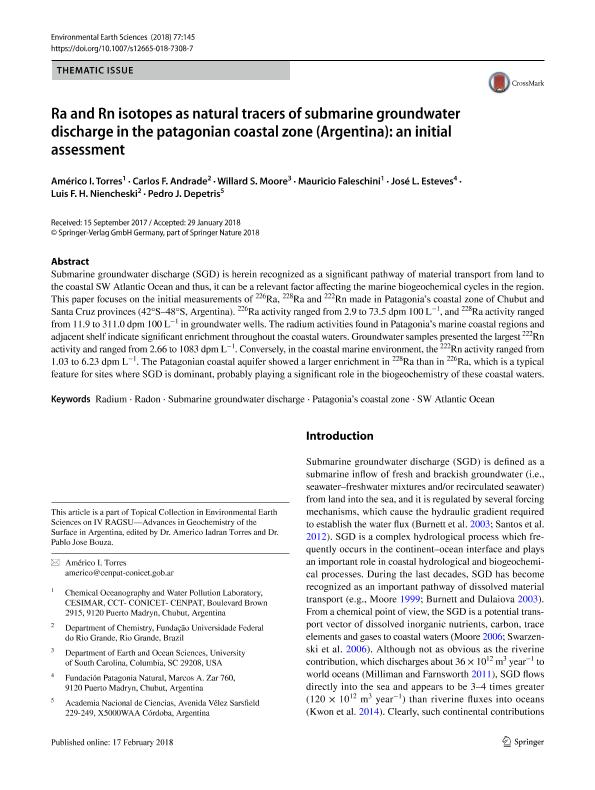Artículo
Ra and Rn isotopes as natural tracers of submarine groundwater discharge in the patagonian coastal zone (Argentina): an initial assessment
Torres, Américo Iadran ; Andrade, Carlos F.; Moore, Willard S.; Faleschini, Mauricio
; Andrade, Carlos F.; Moore, Willard S.; Faleschini, Mauricio ; Esteves, Jose Luis
; Esteves, Jose Luis ; Niencheski, Luis F. H.; Depetris Gallino, Pedro Jose
; Niencheski, Luis F. H.; Depetris Gallino, Pedro Jose
 ; Andrade, Carlos F.; Moore, Willard S.; Faleschini, Mauricio
; Andrade, Carlos F.; Moore, Willard S.; Faleschini, Mauricio ; Esteves, Jose Luis
; Esteves, Jose Luis ; Niencheski, Luis F. H.; Depetris Gallino, Pedro Jose
; Niencheski, Luis F. H.; Depetris Gallino, Pedro Jose
Fecha de publicación:
02/2018
Editorial:
Springer Verlag Berlín
Revista:
Environmental Earth Sciences
ISSN:
1866-6280
e-ISSN:
1866-6299
Idioma:
Inglés
Tipo de recurso:
Artículo publicado
Clasificación temática:
Resumen
Submarine groundwater discharge (SGD) is herein recognized as a significant pathway of material transport from land to the coastal SW Atlantic Ocean and thus, it can be a relevant factor affecting the marine biogeochemical cycles in the region. This paper focuses on the initial measurements of 226Ra, 228Ra and 222Rn made in Patagonia’s coastal zone of Chubut and Santa Cruz provinces (42°S–48°S, Argentina). 226Ra activity ranged from 2.9 to 73.5 dpm 100 L−1, and 228Ra activity ranged from 11.9 to 311.0 dpm 100 L−1 in groundwater wells. The radium activities found in Patagonia’s marine coastal regions and adjacent shelf indicate significant enrichment throughout the coastal waters. Groundwater samples presented the largest 222Rn activity and ranged from 2.66 to 1083 dpm L−1. Conversely, in the coastal marine environment, the 222Rn activity ranged from 1.03 to 6.23 dpm L−1. The Patagonian coastal aquifer showed a larger enrichment in 228Ra than in 226Ra, which is a typical feature for sites where SGD is dominant, probably playing a significant role in the biogeochemistry of these coastal waters.
Archivos asociados
Licencia
Identificadores
Colecciones
Articulos(CESIMAR)
Articulos de CENTRO PARA EL ESTUDIO DE SISTEMAS MARINOS
Articulos de CENTRO PARA EL ESTUDIO DE SISTEMAS MARINOS
Citación
Torres, Américo Iadran; Andrade, Carlos F.; Moore, Willard S.; Faleschini, Mauricio; Esteves, Jose Luis; et al.; Ra and Rn isotopes as natural tracers of submarine groundwater discharge in the patagonian coastal zone (Argentina): an initial assessment; Springer Verlag Berlín; Environmental Earth Sciences; 77; 4; 2-2018
Compartir
Altmétricas



